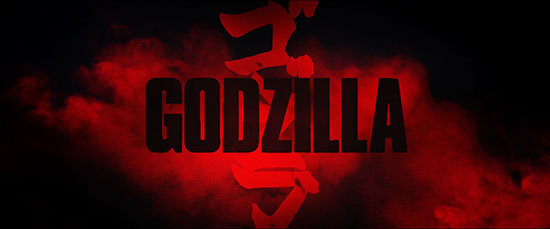
MC: Let’s take a moment to consider the Rubin Vase. I’m sure you have before. Some look at it and see two faces while others look at it and see a vase, when in fact it’s actually both.
I’d argue that the classic kaiju franchise is something similar. Some look at Godzilla and see a giant silly-looking superpowered reptile smashing giant silly-looking prop buildings. In fact, given the notoriously campy direction the franchise has steered toward in the past few decades, that’s probably the majority opinion. But ever since I saw the original Japanese version a few months back, I put myself in the second category: Those who look at Godzilla and see a symbol for mass destruction. All of Tokyo got crushed onscreen back in 1954, and the original film made damn sure to display every last casualty while it was happening. And it was captivating to watch, given the historical context.
So is Godzilla deathly serious or hilariously campy? Most would answer one or the other, but the simple truth is that we can’t have one without the other. Godzilla is — and has always been — both. To that end, anyone tasked with making a worthy Godzilla film must find a way to balance the silly with the somber. It’s a Herculean feat, to say the least, but I’d say that the new American remake pretty much nailed it.
TN: Toho’s repurposing of Godzilla from walking bomb to goofy guardian is really fascinating. I can appreciate exactly why the Toho franchise went the way it did, because you can’t simply have Godzilla come back with the singular motivation to crush a city every time. I’m not a Godzilla fanatic, but I do have a love for movie monsters of all sizes, and my interest in Kaiju films was renewed by Pacific Rim. I wouldn’t say that Gareth Edwards’ remake really nailed the duality of Godzilla, but I don’t think that’s necessarily a fault of the film. It’s really because I was looking for something that confirmed how conflicted I feel about Godzilla’s dual nature. Can we still love a monster that has no motivation but destruction? I think we can, and Pacific Rim proves that (so do lots of other movies, but I’m sure you understand the comparison). While I didn’t love Guillermo del Toro’s mechs vs kaiju live action anime, neither of us can deny that it had a couple of GREAT monsters.
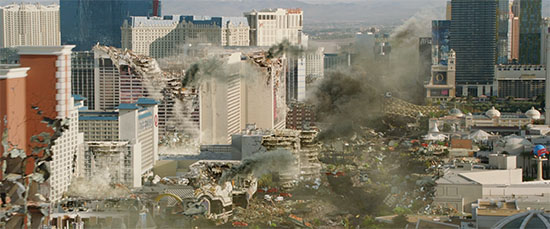
Unlike the Kaiju of Pacific Rim, Godzilla is the peoples’ champion here. By the end, not only does the audience cheer for him, but so do the citizens of a trampled metropolis. The first hour of the film sets him up as something totally different. He’s even referred to as a god, which is something I found totally compelling. I suppose you could say he finds humans and cities as mere obstacles, which I think is exactly how he should feel, given his size and power. I just wish the film didn’t show such gratitude toward Godzilla, because I’m sure a few unlucky folks had to scrape about four hundred flattened Hawaiians off the floor of Honolulu International Airport thanks to his footwork.
MC: We could write a whole article comparing Pacific Rim to this Godzilla remake. One takes place several years into the kaiju invasion while this only shows first contact. One lays out an elaborate backstory for its monsters while the kaiju of Pacific Rim are given very simplistic origins and motivations. And yes, Pacific Rim dealt far more heavily with Kaiju corpses and aftermaths than this movie does. But in my opinion, one of the most crucial differences between them comes back to that one shot when Gipsy Danger punches through a skyscraper and sets a physics toy in motion. Director Gareth Edwards made a very clear point not to include shots like that.
Edwards once said that when he was planning this movie, he deliberately avoided shots that weren’t physically possible. Every shot had to look as if the camera was placed on the street, on a rooftop, or at least on a helicopter. Naturally, this gives the film a very grounded and immersive feel without resorting to excessive shaky-cam. Quite clever, really.
From start to finish, this movie puts its focus squarely on the human element. When the film opens with a nuclear reactor meltdown, we see it from the perspective of Joe Brody (Bryan Cranston) losing his wife (Juliette Binoche). When San Francisco gets torn apart at the end of the film, we see it entirely through the eyes of Ford Brody (Aaron Taylor-Johnson). A building could get demolished or a monster could pass by, yet the camera stays focused on the terrified human beings who are running for their lives. This approach stays true to the original film while also setting it apart from most other CGI disaster films, and it’s very well done.
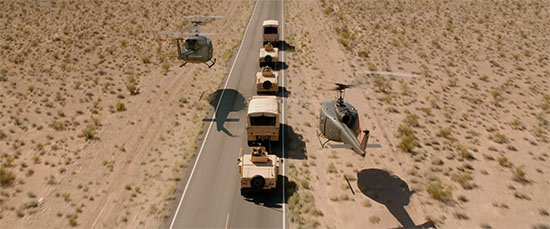
However, this approach does have some drawbacks. Right up until the climax, such a heavy emphasis is placed on the human lives in danger that we barely see any monster-on-monster action. There’s one moment in particular when so much effort is put into building up Godzilla, then he shows up and he roars and it’s awesome… then the camera cuts to another scene and we see someone else watching the fight on television. It was all I could do to keep from shouting “COME ON, MAN!”
TN: That really was the most frustrating thing about the film, because we’d been waiting so long for this massive throwdown, and Edwards fucking aces the buildup. It’s a tease that feels completely wrong, and it feels like the film is attempting to be smarter than us by holding off. “Oh, we know what you want, but you can’t have it yet. You’ll just have trust me, the end will be totally worth it.” While the climactic battle is a jaw-dropping set piece, there’s no good reason to deprive us of a mid-movie monster mash. Pacific Rim proved that, too.
The buildup to the skipped Honolulu fight is one of the film’s several Jurassic Park moments: characters are on an outdoor tram when suddenly the lights go out and the tram screeches to a halt. An enormous monster crashes through the dense, dark jungle, and just as the tram lights come back on and the tram starts moving again, a huge mouth fills the window of the tram car, and suddenly the car and track are smashed, the car tilting crazily toward the tarmac apron below. It’s great stuff, and like Jurassic Park‘s T-Rex attack, it’s all from the human perspective. There are no god’s-eye perspectives of the action. It’s never too busy or incoherent, and uses well-timed cuts to create a sense of coherence.
There are lots of nods to Jurassic Park in the film, which leads me to believe that perhaps Edwards would be a great choice to helm a future installment in that franchise. Just to show how overt these influences are, the opening of Godzilla features a blue and white helicopter flying over mountainous green jungle. The helicopter lands at a dig site, blowing dust everywhere. A scientist and his female companion step out of the helicopter, and are greeted by a man in a suit who wants to show them some fossils. It would feel like a rip-off if it wasn’t so well done. Another example: my favorite shot of the film takes place entirely from inside a school bus, and we hear screams of panic as the camera tracks Godzilla through the rear windows of the bus. It’s crazy how much it feels like Spielberg’s T-Rex attack.
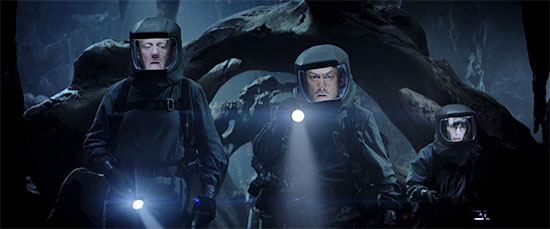
MC: The comparisons to Jurassic Park are quite intriguing, and frankly rather genius. If you’re going to bring some fresh blood to the kaiju genre, that film is an inspired choice to pull from.
Anyway, the first half plays out like a kind of suspense thriller. We witness signs, tremors, government cover-ups, and assorted weird shit happening, as Joe relentlessly chases after ghosts while Ford plays the skeptic. It’s all foreshadowing to help establish what these monsters are and where they came from in this reboot’s mythology. Yet even after all of that, I still couldn’t give you a good explanation as to why these monsters are attacking each other, or why they all laid dormant until this exact moment in time. Don’t get me wrong, I realize that any serious attempt at explaining something so crazy is going to smell like bullshit no matter what, and even a token attempt does a lot to help suspending disbelief. On the other hand, when so much time and effort is put into explaining a backstory that still doesn’t make any sense, that’s kind of a big fucking problem.
TN: The origin of the film’s baddies is not explained. All we know is that a mining company in the Philippines drilled into an ancient cavern, and the fresh air caused a long-dormant egg to hatch. The creature that slithered out of that egg went to Japan to feed on radiation for fifteen years, and by pure coincidence it emerged from its larval state just in time for Ford and Joe to see it happen. There is a fair amount of coincidence to propel the film forward, like when Dr. Serizawa requests that the Joe and Ford be brought along with him for no apparent reason other than one of them had noticed a disturbing pattern in seismic activity.
MC: The whole plot is built on contrivances, most of it revolving around a huge exposition dump near the end of the first act. I’d be interested to watch that scene again and see if there’s anything the pair of us missed on the first viewing. Then again, if it takes multiple viewings to get a basic understanding of something so crucial, that’s not exactly good storytelling.
Speaking of which, for all of this film’s attention on the poor humans getting slaughtered, our main characters are all quite bland. Ford is a protagonist who’s completely unmemorable, Elle (his wife, played by Elizabeth Olsen) doesn’t do much of anything to advance the plot, and the only reason why Joe works is because he’s being played by Bryan fucking Cranston. This guy could take the most stock character imaginable and still find a way to make it entertaining, and that’s basically what he does here.
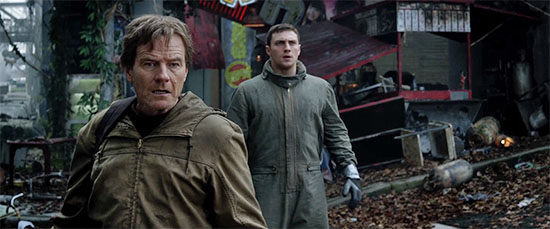
Of the three, I’m sorry to say that Olsen was the worst fit for her character. Don’t get me wrong, I’m a big fan of hers, but she doesn’t have enough maturity to play the mother of a five-year-old boy (Sam Brody, played by Carson Bolde) and she doesn’t have the chemistry to play Taylor-Johnson’s wife. The two of them have enough of an easy rapport to play siblings (and I can’t wait to see them play twins in the next Avengers), but as a married couple? Sorry, the spark just isn’t there.
TN: I also had some issues with the central cast, mostly because Bryan Cranston is relegated to the role of the cranky crackpot scientist who gets to scream “I warned you this would happen, and nobody listened! Who’s the crazy one now?!”. He’s completely misused. Cranston is now a leading man through and through, and would have been a much more solid anchor than Aaron Taylor-Johnson’s flat lead. Pairing Cranston with Ken Watanabe as a scientist duo might have been a great dynamic, but it’s not explored at all. I can’t help but feel a huge missed opportunity there. I also agree that Olsen is a bit fresh-faced for the mom role, but I think she could have pulled it off if she were given something a bit more substantial.
MC: No doubt. As for the supporting cast, Juliette Binoche only gets a handful of scenes before getting killed off, and Sally Hawkins seems to have absolutely no idea what she’s doing in this picture. David Straithairn appears as a Navy admiral who’s just zealous enough to be competent but not enough to be a living stereotype, landing somewhere in a beige sweet spot. Ken Watanabe lends Japanese credibility to the picture and gravitas to some terribly cheesy lines.
(Side note: Watanabe’s character is named Dr. Ichiro Serizawa, an obvious reference to Dr. Daisuke Serizawa, who played a pivotal role in the original Gojira movie. So pivotal, in fact, that Pacific Rim paid tribute to the character by way of the “Serizawa scale” used to place kaiju into categories. But I digress.)
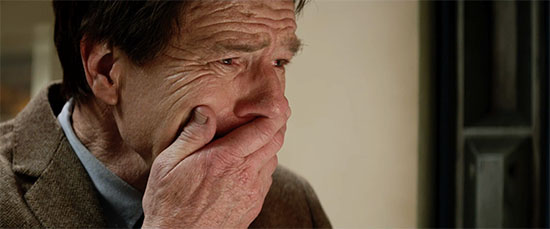
It’s tempting to knock the film for placing such a huge emphasis on such stock characters. But on the other hand, it bears remembering that this was always going to be a losing battle. The simple truth is that no one cares about the human characters because we all came to see the giant monsters. No matter how interesting a human character may be, they will never be anything more than a distraction next to freaking Godzilla. As such, we only need the main human characters to be our eyes and ears on the ground, providing us with emotional stakes for the destruction going on. Given that the characters are all given clear motivations, they’re all passably competent at what they do (given the unusual circumstances), none of them grate the nerves, and none of them waste time with petty infighting, they serve this purpose well.
TN: Functionally, however, these characters are the only reason we move from one set piece to another and still manage to feel something other than the thud of gargantuan footsteps, but I fear that injecting a more complex human story that would have run parallel to the Godzilla narrative might have made it like Super 8, in which the human drama had absolutely nothing to do with the monster. The two plots simply ran in parallel and collided messily on several occasions. That doesn’t happen in Godzilla, thankfully, but I feel that focusing on Cranston’s character, dialing his mania back a bit, and recasting Ford might have made the film much better.
I also took issue with the way the film tied its characters to bombs. Ford does Explosive Ordinance Disposal, which his father seems to conveniently forget right when the audience is wondering what EOD stands for. This is an interesting profession for Ford to have, because he represents the dismantling of the major motivating force that created the character of Godzilla in the first place. What seems weird is that we never see Ford use his abilities to do what he does best: preventing a bomb from exploding. Instead, he’s used to do the exact opposite. Ford is an impotent anti-bomb in the same movie with the world’s biggest walking atomic bomb metaphor.
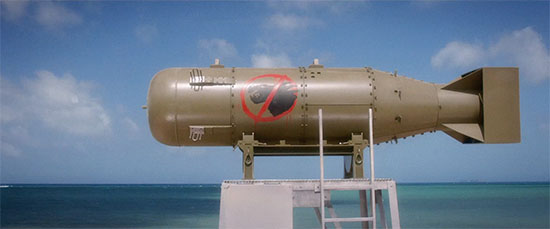
MC: Personally, I feel that Taylor-Johnson did the best he could with what he had. He’s a good actor, but he’s not good enough to elevate such a weak character (like Cranston is and Olsen isn’t). That said, it is rather strange that he never disarms a bomb, especially when the climax puts him in a position to do just that.
Now, at last, we turn to the monsters. At this point, you may have noticed how I keep referring to “monsters” as plural. See, the filmmakers were evidently smart enough to realize the aforementioned “Rubin’s Vase” nature of Godzilla. He’s both a monster and an icon, which means that he needs to be presented as a threat and a hero at the same time. The demolition has to end, but it can’t end with Godzilla’s death or the franchise will need some convoluted way to bring him back for sequels. To that end, the filmmakers introduce a monster for Godzilla to fight, so we can all have our cake and eat it too.
In this case, the other giant monster is the Muto (which is actually an acronym for Massive Unidentified Terrestrial Organism), a parasitic creature that seems to have no greater goal than its own procreation. What’s more, the Muto feeds on radiation and has the ability to create EMPs. Basically, the Muto is a true force of nature. Much like a tsunami, a volcano, or some kind of super-plague, the Muto simply goes about its business completely unaffected by human technology. We could throw our biggest nuclear bomb at this thing and it wouldn’t do any good. It’s so far above humanity and so far removed from our capacity for harm that the Muto barely seems to notice our existence.
And here’s the kicker: There’s no Oxygen Destroyer this time. No high-heat sabot rounds, no computer virus in an ApplePowerbook, no big bad weapon made from human hands that magically arrives to save the day. The United States military does a great job of minimizing casualties and controlling the damage, but there’s never any illusion that they stand a chance at defeating Muto once and for all. That’s where Godzilla comes in.
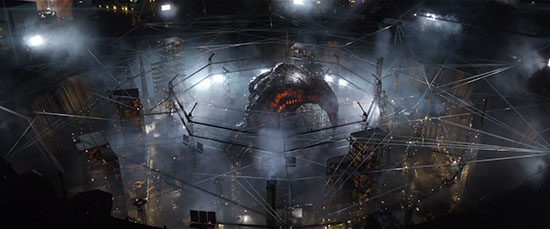
TN: I really liked the MUTOs in the film. They manage to feel very Toho, despite their more contemporary look. The angular, six-limbed design was unique, and I loved the glowing eyes and beak-like face. Their radiation consumption and electric attacks make them perfectly suited for action figures. They actually provide the film with some of its more unique moments, too. There’s a sequence involving a MUTO and a web of cables in the film that was superbly designed and executed. There’s also a wonderfully bizarre moment when a mind-boggling and tender mating ritual occurs. I could hardly believe what I was seeing, and I loved it so much I’m still grinning about it now.
Let’s not forget about the big guy himself, though, because he looks –and sounds– amazing in the film. His face is very expressive, and I love the design of his hands, oddly enough. The way his tail whips around seems very real, if a bit reminiscent of Emmerich’s Godzilla. Unlike the lithe Patrick Tatopoulos design that Emmerich used, this Godzilla’s legs are trunk-like and cylindrical, and his spines are perfect, especially when he unveils their true function.
MC: On the one hand, Godzilla is fantastic in this movie. His design looks great, his movements showed a lot of personality, and somehow, watching him roar over and over again never got old. His fight scenes are also suitably epic, and I almost cheered out loud when his radioactive breath was finally let loose. In terms of spectacle, Gojira rocked. In terms of character, however, there was a lot to be desired.
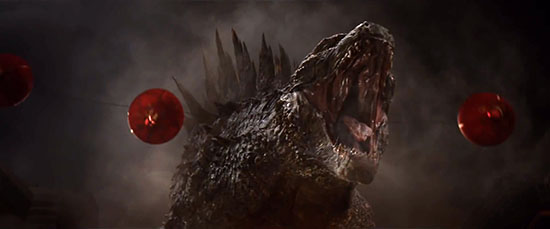
Muto was always far more interesting than Godzilla, and that’s by far my biggest problem with this movie. I understood Muto’s motivation to feed and procreate, and that did a lot to establish Muto as a symbol of nature’s unstoppable wrath. But when it comes to Godzilla’s motivation, there’s no decent reason behind his feud with Muto. All we get is Serizawa talking about how Godzilla is there to “restore balance,” like that means anything.
TN: The idea of restoring balance is frequently mentioned in the film, and I suppose it’s better than no motivation, but I like that it reinforces the idea of Godzilla as a god or elemental, something that operates with no regard for humans. It also makes him more like an animal, in that his drive to kill other creatures could be territorial or instinctual. It works, but just enough to get the plot to function on a basic level.
MC: It seems like that was the standard for all the characters in this film: “Just enough to get the plot to function on a basic level.”
Finally, I’d like to give a substantial amount of credit to Alexandre Desplat, who composed a delightfully epic score for this picture. The man is a tremendously underrated composer, and his music is a key part of why this film works so well. Of course, the other big reason was Gareth Edwards. In retrospect, his previous Monsters film was all about showing the chaos of giant monsters from a grounded human perspective, with a bit of political allegory thrown in, which made it a perfect demo reel for this project. Maybe it’s just me, but I’d love to see Edwards reunite with Scoot McNairy for the next Godzilla flick.
TN: I’ll disagree when it comes to Desplat’s score. He’s been hit-or-miss with me, and I really think he’s better suited for stuff like The Grand Budapest Hotel, which he knocked out of the park. The score for Godzilla serves its purpose without ever becoming unwelcome, but it never supported the enormous iconography of our monster. It was just there, as part of the film’s soundscape. There are two moments that stood out for me musically: the first was Godzilla’s triumph, when the brass section plays a suitably triumphant note, and then, in an odd moment of synchronicity, Godzilla seems to roar/sing the same exact pitch, then the brass plays it again. But nothing was more effective than the low “bwaaaamm” that announces Godzilla’s arrival in Honolulu. As tired and as silly as “bwaaaamms” have become in this age of action films, sometimes they just work.
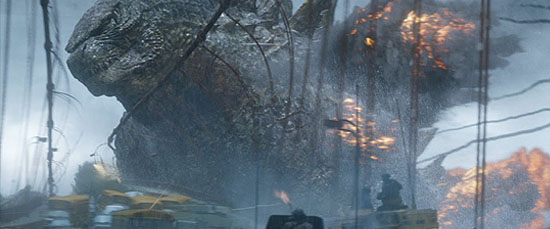
MC: Godzilla (2014) is hardly a perfect movie, but most of its flaws are inseparable from the material. It may have a thin plot and bland central characters, but then, so did the original film. The basic concept of giant radioactive monsters come from nowhere to destroy us will always be a silly concept no matter what attempts are made to the contrary, but take that away and this franchise wouldn’t be nearly as iconic or novel. Quite wisely, the reboot chooses not to fix or ignore these “problems,” but to embrace them as part of its heritage.
TN: I agree that most of its flaws are often part and parcel of kaiju films, but I think some additional script tinkering could have produced something that was more compelling and enjoyable on the human side. I also think the mid-movie tease may be the film’s roughest burr, and I doubt it will be worn smooth with time. I suspect that when I watch this film in a few years, I’ll still get that blue-balls feeling as the movie falls flat on its giant face. Again, I also wish the film hadn’t attempted to exalt Godzilla as humanity’s savior, and perhaps went for a more complex ending that left room to deal with humanity’s confusion and fear regarding the humongous lizard-monster they just found out was hiding somewhere on their planet. But that those issues aside, I feel that Godzilla’s strong action beats and memorable moments will help it to be regarded as one of this summer’s best action films.
MC: If you’ll pardon the excuse, I’m sure there will be room to question Godzilla’s motives and morality in later movies. Maybe next time, we could have some kind of effective human resistance in place (the Earth Defense Force?) so we wouldn’t have to treat Godzilla as our savior. Right now, I’m content to have a film that uses giant monsters and rampant destruction to depict our growing sense of impotence against natural disasters that seem to come more frequently every year.
Travis’ Rating: 




Out of a Possible 5 Stars